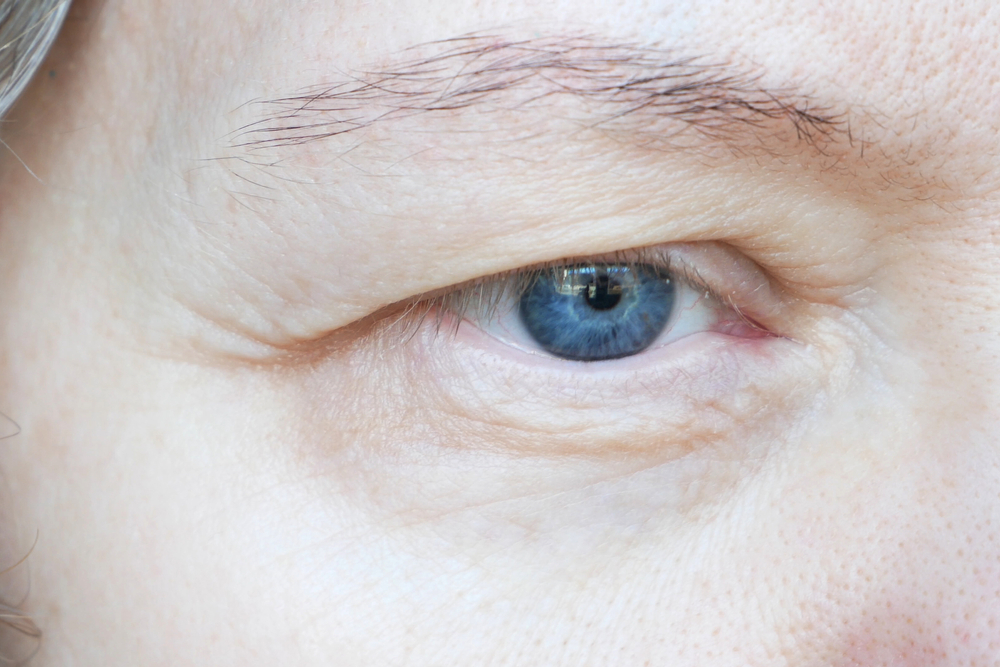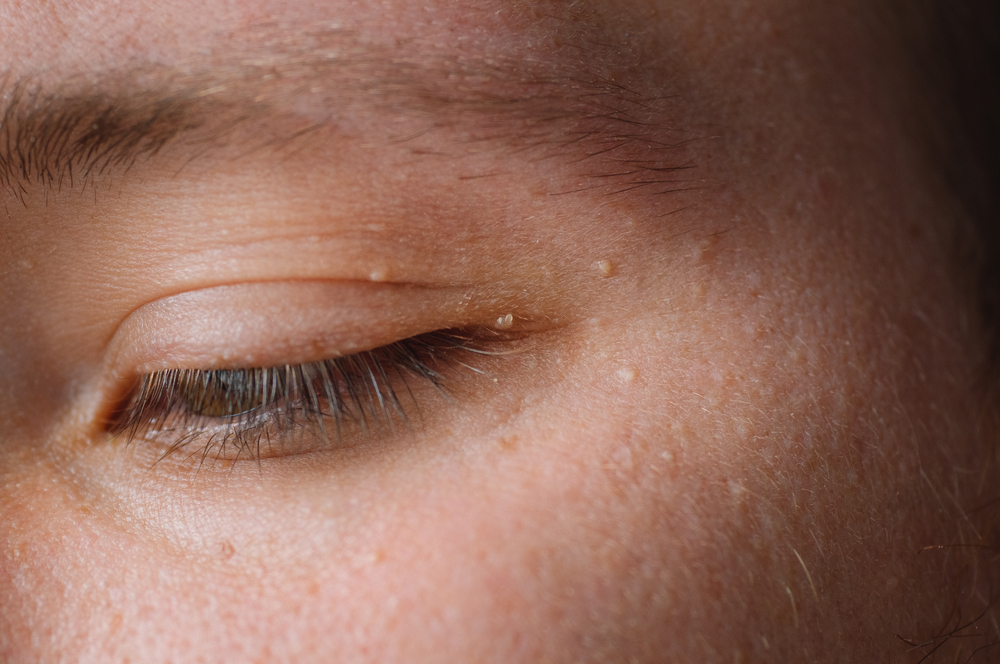Many parts comprise the eyelids, eyelashes, brows, tears, and how you see. If something goes wrong, an oculoplastic surgeon can help. The oculoplastic procedures offered at Maine Eye Center can help with issues like droopy lids, bulging eyes, excess tears, and more.
Dermatochalasis
Dermatochalasis is a condition that occurs when the skin on the upper eyelid becomes loose and saggy. As a result, vision can become obstructed, or skin on the eyelids can look droopy.
An oculoplastic surgeon can remove excess skin to lift the eyelid, improving vision and helping you look more alert.

Ptosis
Ptosis occurs when the eyebrows droop down, making you look tired. It may also obstruct your ability to see clearly.
You can treat ptosis by tightening the muscle that lifts the eyelid, which allows the eye to open more, helping you look more awake.
Brow Ptosis
Brow ptosis is a condition that occurs when the eyelids droop down, leaving you looking more tired than you are. It also affects your visual field. Your Maine Eye Center oculoplastic surgeon can lift your brows by removing extra skin and fat above the eyebrows as necessary. Lifting the brows helps them look more arched and open-eyed.
Excess Tearing
Excess tearing happens when you make too many tears. These excess tears spill out of the eyes.
This can be due to blocked tear ducts, eye irritation, or other causes. Your ophthalmologist can determine the root cause of excess tearing and clear blocked tear ducts to help your tears drain more efficiently.
Entropion
Entropion is an eye condition that occurs when the eyelid turns in. When this happens, the eyelid rubs against the cornea and eye, causing irritation.
Your oculoplastic surgeon can correct entropion with a surgical procedure to flip the eyelid out so it no longer rubs against your eye.
Ectropion
Ectropion is an eye condition that’s the opposite of entropion. With ectropion, the lower eyelid turns out and exposes the inside of the eyelid and eye.
Doing this causes irritation and more watering in the eye. Your eye doctor or an oculoplastic surgeon can perform a procedure to tighten muscles in your eyelid or skin to flip your eyelid back up. Tightening these muscles helps prevent rubbing and further drying out in your eye.

Eyelid Lesions
Eyelid lesions refer to bumps or lesions that can develop on your eyelids. Common bumps that may develop include chalazion, styes, and papilloma.
If you have lesions that won’t disappear, your eye doctor can remove them. Removing these lesions prevents spread, rubbing, and blockage on your eyes. Biopsies can check to see if eyelid lesions are cancerous.
Orbit Lesions
The orbit refers to the eye socket, and tumors or cysts can grow here. Your eye doctor can biopsy any lesions that develop on the orbit to check for signs of cancer.
If there are benign lesions, these can be observed or removed. Surgery may be necessary to prevent vision loss from orbital masses.
Thyroid Eye Disease
Thyroid eye disease (TED) can cause the eyes to bulge, called proptosis or exophthalmos. Patients with thyroid eye disease may experience swelling and fat in the eye muscles behind the eyes.
Your eye doctor will work with a thyroid physician to treat the condition and help reduce swelling to move the eyes back into their proper place.
Enucleation
Patients who have experienced severe eye injuries or conditions can go blind, suffering pain while doing so. If medicine doesn’t help, removing the eyes may be necessary.
A surgical procedure to remove the entire eyeball is called enucleation. Enucleation removes the eyeball but leaves the eyelids, eyelashes, eyebrows, and surrounding skin intact.
Evisceration
Evisceration is less extensive than enucleation. Like enucleation, it leaves your eyelashes, eyebrows, and eyelids intact.
However, it preserves the scleral shell of your eye and the muscles that allow your eye to move.
Exenteration
If it’s necessary to remove the eye and other adjacent structures, like the eyelids, fat, and eye muscles, your oculoplastic surgeon will perform exenteration. Exenteration is the most extensive procedure and is often performed on patients with eye cancer that has spread to surrounding tissues.
Orbital Fracture
An orbital fracture is an injury to the orbit, which is the eye socket. You can injure the orbit due to trauma from things like a car accident or receiving a blow to the face or head.
Signs of an orbital fracture can include double vision, bruising of the eye, and numbness. An oculoplastic surgeon can repair an orbital fracture by putting plates and screws in place to hold the fragments in to heal.
Blepharospasm
Blepharospasm is a condition that causes the eyelids to twitch and close tightly. Because of this, the eyes will blink and shut against your will.
Patients with blepharospasm will experience it repeatedly, usually for a long time. Eye exercises may be able to help reduce spasms.
Your Maine Eye Center oculoplastic surgeon may use Botox injections to treat blepharospasm by temporarily paralyzing eyelid muscles to give more control over blinking.
Hemifacial Spasm
Hemifacial spasm makes one side of the face twitch. It often begins with fluttering of the eyelid before spreading down the cheek, mouth, and neck muscles on the same side of the face.
This can happen many times a day. Botox can be used to relax the spasming facial muscles, which helps reduce twitching and fluttering. Using Botox can help with symptoms for several months before needing repeat injections.
Botox
Botox is derived from botulinum toxin type A. When injected in small doses into your muscles, it blocks signals from the nerves into the muscles, which causes temporary paralysis.

Botox can be used cosmetically to smooth out wrinkles and improve the appearance of crow’s feet, forehead lines, and frown lines. It keeps these muscles from contracting to make you look younger.
However, you can also use Botox for medical uses for things like treating migraines, excessive sweating, and correcting lazy eyes, among other things. The effects of Botox, both medically and cosmetically, last about 3-6 months as the body gradually absorbs it. Botox must be reinjected to maintain its results.
Xeomin
Xeomin is a purified form of botulinum toxin that works like Botox but has fewer ingredients. Like Botox, you can use it cosmetically to smooth out the appearance of wrinkles and lines like crow’s feet, forehead lines, and frown lines.
Xeomin can also be used in medical situations to treat conditions like chronic migraines and eyelid spasms.
Learn more about the oculoplastic procedures offered at Maine Eye Center in Portland, ME, by requesting an appointment today!
